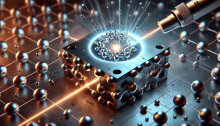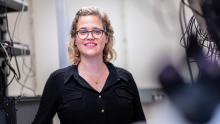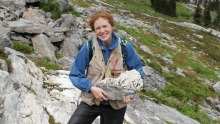New research by UBC physicists indicates that high-temperature superconductivity in copper oxides is linked to what they term 'incoherent excitations'--a discovery that sheds light on the electronic response of these materials before they become superconducting.
The study marks the first time researchers have been able to directly measure when electrons in a super conductor behave as independent well-defined particles, and when they evolve into ill-defined many-body entities.
"We've never been able to directly quantify the nature of electron behaviour within these materials across the entire phase diagram--the transition from non-superconducting to superconducting behaviour," says Associate Professor Andrea Damascelli, Canada Research Chair in Electronic Structure of Solids with the Department of Physics and Astronomy.
"A combination of advanced spectroscopic techniques, and access to very pure cuprate crystals produced at UBC have allowed us to measure what's going on below the surface of a high-temperature superconducting material through the entire progression of different phases."
The paper, the first out of the newly created Quantum Matter Institute at UBC in collaboration with researchers from the Advanced Light Source at Lawrence Berkeley National Laboratory, was published this week in the journal Nature Physics.
Cuprates normally act as insulators but become superconductors when electrons are removed--a process known as 'doping' holes into the material. Physicists consider a material optimally doped when it achieves superconductivity at the highest, most accessible temperature. A material is 'underdoped' when its level of doping is less than the level that maximizes the superconducting temperature.
A central debate in the field has focused on whether high-temperature superconductivity--the ability to conduct electricity without resistance at record high temperatures--emerges from a fluid of individual Fermi liquid quasiparticles (the electron-like entities ‘dressed’ by the interactions with their surrounding that give rise to conventional low-temperature superconductivity), or is instead a property connected to the physics of ‘strongly-correlated’ Mott insulators, in which many-body electron behavior wipes quasiparticles completely out of existence.
Damascelli's team was able to measure a rapid loss of quasiparticle integrity in the material's electron behavior upon entering the cuprates' underdoped phase. "This implies that some very important concepts of Fermi liquid models breakdown entering this phase, and that we'll have to look in other theoretical directions to explain superconductivity."
UBC is world renowned for research excellence in quantum materials, and announced the establishment of the Max Planck-UBC Quantum Materials Center last week and the creation of a dedicated Quantum Matter Institute last May.
Read the Nature Physics Paper
http://dx.doi.org/10.1038/NPHYS1763
Musqueam First Nation land acknowledegement
We honour xwməθkwəy̓ əm (Musqueam) on whose ancestral, unceded territory UBC Vancouver is situated. UBC Science is committed to building meaningful relationships with Indigenous peoples so we can advance Reconciliation and ensure traditional ways of knowing enrich our teaching and research.
Learn more: Musqueam First Nation
Faculty of Science
Office of the Dean, Earth Sciences Building2178–2207 Main Mall
Vancouver, BC Canada
V6T 1Z4


